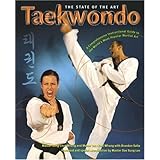
Average Reviews:

(More customer reviews)Taekwondo The State of the Art
Authors:Masters Sung Chul Whang; Jun Chul Whang; Brandon Saltz; Foreword and contribution by Master is comprehensive and deals with History, Philosophy, Warm ups; Stances; Steps and Footwork; Blocks; Hand strikes; Kicks; Sparring; and Poomse. The authors have chosen to use illustrations rather than photographs and the results are quite good. Korean terms are used throughout as part of the titles. Headings for almost all sections in the book and all the stances, kicks, strikes, blocks, etc. are included. As always, since English sounds don't always match Korean, the spelling is a crap shoot. Of particular note is the use of G instead of K for a palatal consonant in such Korean words as (Gyoroogi) (sparring) here versus Kyorugi in some other books.
Of all the books I've read, I like this one the best-so far. There is more detail and supporting discussion. As I read the material, I felt like I was being coached by someone who was not only very competent, but also someone who understood the problems of junior belt level students such as myself.
This book will appeal to the serious Taekwondo students no matter what reasons they have for taking Taekwondo. It is only missing discussion of self defense. However, there is a frank discussion in the philosophy chapter that addresses the authors' feelings about the thought processes of people in the discipline about the merits of sportized Taekwondo versus martial art. This is an important discussion and should be read by young Taekwondoists as they determine why they are taking TKD. [For the dedicated student, The Martial Artist's Book of Five Rings by Miyamoto Musashi interpreted by Stephen F. Kaufman, Hanshi 10th Dan, has even more relevant discussion.]
The book deals with stances, hand strikes and kicks and stresses the rationale behind each. It is detailed in its discussion and maintains the importance of the proper stances and striking technique. The extensive section on steps and footwork is the most comprehensive I've see so far. They discuss transitions from position to position. With these sections the authors build you carefully towards the sections on sparring and poomse(forms) Because of the lengthy build up, only the Taeguk patterns are shown. The authors acknowledge other patterns such as the Palgwe, but focus on the current WTF authorized patterns. The discussion on the patterns is excellent. If read with the preceding material in their book, a student can greatly increase their understanding of why they are doing things and how they may improve. [Please understand that no-one should feel they can learn Taekwondo properly without the instruction of a Master such as Master Seung. No book replaces an experienced teacher, but it offers some insights and additional information that may not come up in the classes very often.]
What makes this book especially appealing to someone like me, is the information about the Taeguk series-the Taeguk is the circle containing the um/yang symbols within the 8 sets of 3 bars. For the first time as a Taekwondo student, I could start to understand the significance. The authors have given us a brief but important opening into the discipline.
In addition, they have advanced an image of the ultimate state to which patterns should aspire. It demonstrates the purpose of each motion.
As a beginning, but serious TKD student, if I could only buy one book on Taekwondo, I would buy this one.
Click Here to see more reviews about: Taekwondo: The State of the Art
A comprehensive instructional guide to the world's most popular martial art. 16-pp. photo insert. 350 illustrations. Media attention.
Click here for more information about Taekwondo: The State of the Art

0 comments:
Post a Comment